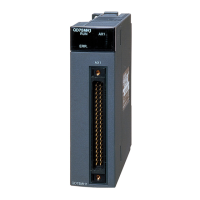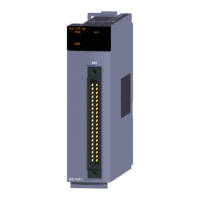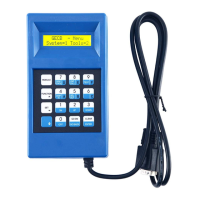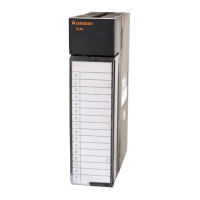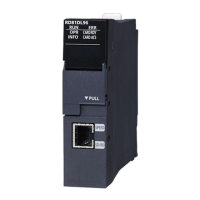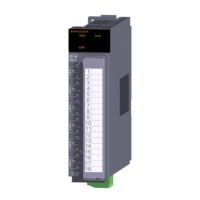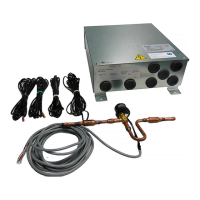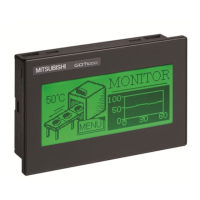
Do you have a question about the Mitsubishi Electric CC-Link IE-NZ2GNSS2-16DTE and is the answer not in the manual?
| Brand | Mitsubishi Electric |
|---|---|
| Model | CC-Link IE-NZ2GNSS2-16DTE |
| Category | Control Unit |
| Language | English |
Lists the specific products covered by this manual.
Lists generic terms and their abbreviations used in the manual.
A comprehensive list of product models and their specifications.
Outlines general environmental and physical specifications for the module.
Details the operational performance characteristics of the module.
Specific performance specifications for the input module.
Performance specifications for the output module.
Performance specifications for the I/O combined module.
Defines the time taken for safety responses, including input and output.
Lists all available functions and their applicability to different modules.
Describes how the module transitions between operation modes and states.
Key factors to consider when planning the safety system configuration.
Procedures for installing, wiring, and setting up the safety remote I/O module.
Lists compatible hardware and software for the safety system.
Lists the safety standards the product complies with.
How to set the module's IP address using the rotary switches.
Guidelines for choosing an installation location and environment.
Shows the different orientations for installing the safety remote I/O module.
Procedures for physically mounting the module onto a DIN rail.
Step-by-step guide for mounting the module onto a DIN rail.
Steps to safely remove the module from the DIN rail.
Instructions for wiring the module's power supply and ground terminals.
Procedures for connecting and disconnecting cables to the terminal block.
Important precautions for cable wiring and terminal handling.
Steps for connecting and wiring the Ethernet cable to the module.
How to wire external devices to the I/O terminal block.
General precautions for handling Ethernet cables and connectors.
Procedures for connecting and disconnecting cables to the terminal block.
Wiring considerations specifically for the input terminals.
How to configure network settings for module communication.
Setting up the network topology for module communication.
Configuring the communication mode for data transfer.
Setting the interval for communication cycles between stations.
Procedures for setting module parameters via the engineering tool.
Automating parameter setup for slave stations via the master station.
Details on parameter data for input, output, and I/O combined modules.
Details on parameters that can be configured per station.
Configuration steps for establishing safety communication.
Validating the safety module's configuration and parameters.
Procedures for processing slave station parameters.
How the module handles safety input signals.
Options for selecting safety input wiring methods (single or double).
Using single wiring for safety inputs, applicable for safety devices.
How the module handles standard input signals.
Options for selecting standard input wiring methods.
Adjusting input signal response times to reduce incorrect inputs.
How the module handles safety output signals.
Options for selecting safety output wiring methods (single or double).
How double outputs are combined and evaluated for safety.
Method for setting safety output wiring selection.
Enables high-speed output control directly from inputs.
Available logic patterns for the fast logic function.
Prevents unintended restarts of fast logic outputs.
How the fast logic function starts and operates.
Behavior when safety output enable signals are off.
Calculates total response time for fast logic operations.
How to configure fast logic function parameters.
Functions for diagnosing input signal failures.
Detects errors when input signals differ.
Mechanism for detecting discrepancies between double input signals.
Automatic recovery from input discrepancy errors.
Setting the time duration for detecting input discrepancies.
Tests input circuits for failures by outputting dark test pulses.
Settings to enable or disable the input dark test function.
Configures the OFF pulse time for input dark tests.
Functions for diagnosing output signal failures.
Tests output circuits for failures by outputting dark test pulses.
Verifies external output signals are correctly output.
Functions that protect the system from overvoltage and overcurrent.
Controls access to the module and CPU based on user authentication.
Configures the communication speed for the module.
Daily checks to ensure proper operation and identify potential issues.
Periodic inspections for long-term reliability and performance.
Using diagnostic tools for troubleshooting CC-Link IE TSN communication.
How to view station status and information using diagnostic tools.
Interpreting LED indicators for troubleshooting module status.
Troubleshooting steps when the D LINK LED flashes.
Troubleshooting steps when the SAFETY LED is off.
Troubleshooting steps when the I/O LED flashes.
Performing a unit test to check for hardware failures.
Steps for troubleshooting based on observed symptoms.
Troubleshooting steps when a safety output fails to activate.
Common fault examples and their solutions.
Specific guidance for troubleshooting input circuits.
Specific guidance for troubleshooting output circuits.
Procedures for checking and interpreting error codes.
A comprehensive list of error codes and their meanings.
Details on safety I/O signals used with the module.
Lists all safety remote I/O signals, categorized by module type.
Safety I/O signals specific to output modules.
Safety I/O signals for I/O combined modules.
Detailed information on safety remote input signals.
Status flag indicating fast logic function is enabled.
Detailed information on safety remote output signals.
Lists available remote control/monitor signals.
Lists the available remote registers for master/local modules.
Detailed descriptions of remote registers like status and error codes.
Lists all addresses and areas within the remote buffer memory.
Parameters configurable per station, including safety settings.
Parameters specific to input modules, like wiring and response time.
Parameters specific to output modules, like wiring and dark test settings.
Parameters for I/O combined modules, covering inputs and outputs.
Settings for detecting double input discrepancies.
Settings to enable or disable the input dark test function.
Configuration for output wiring methods (single or double).
Settings to enable or disable the output dark test function.
Precautions for meeting Electromagnetic Compatibility (EMC) Directive requirements.
Guidelines for installing the module within a control panel.
Recommendations for using shielded cables and proper grounding.
Requirements for external power supplies connected to the module.
Using noise filters to reduce conducted noise on power supply lines.
Conditions for compliance with Low Voltage Directive requirements.
How to calculate target failure measures for safety system applications.
Methods to check the module's production details via rating plate or diagnostics.
How to check the module's firmware version using station information.
Lists new functions introduced in specific firmware versions.
Specifies limitations and exclusions of the product warranty.



